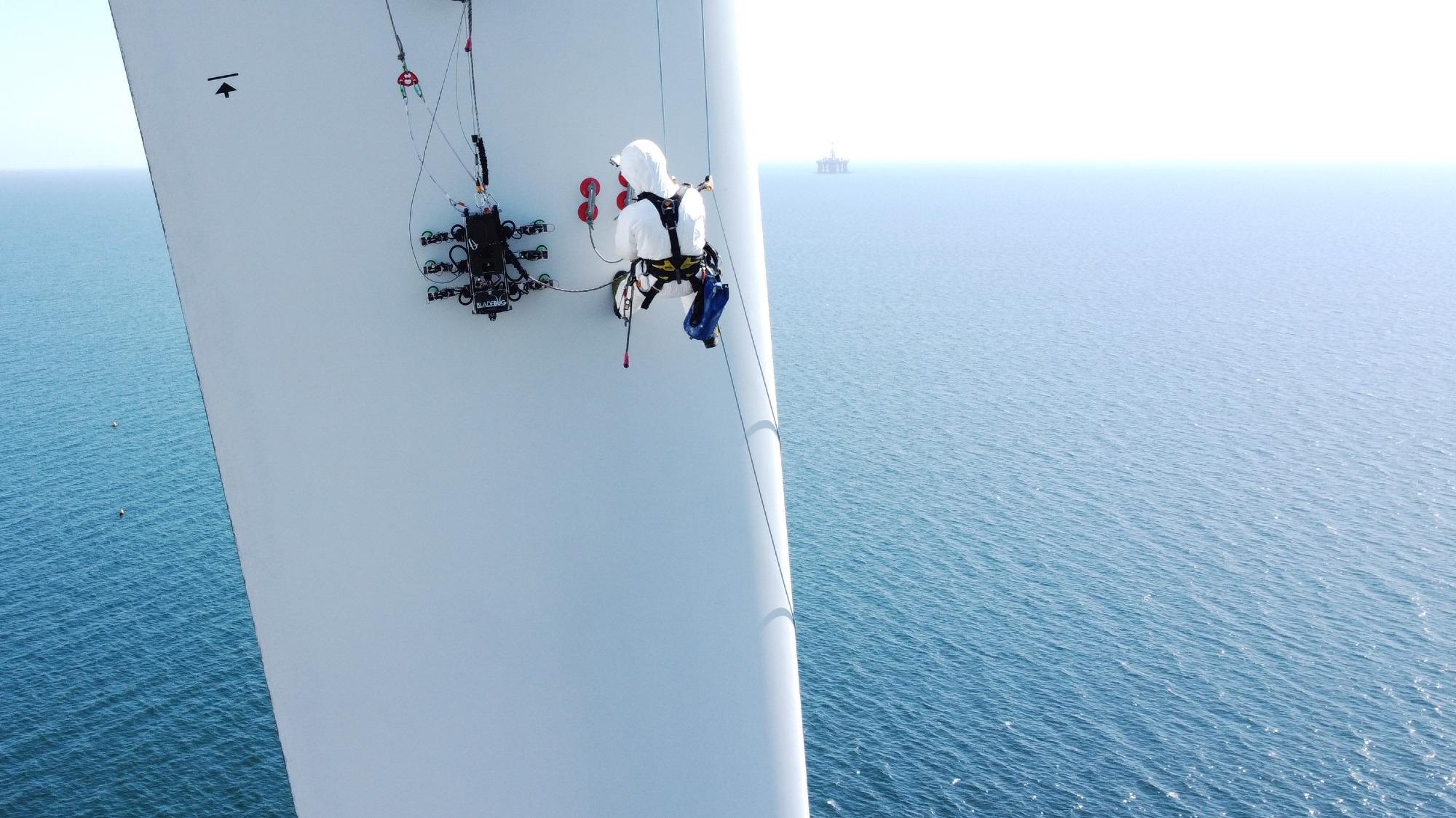May 26 2021
Two UK innovators have joined forces in a mission to develop a robotic solution for ensuring the integrity of the millions upon millions of bolts that hold wind turbines together, a move that is described as essential to the expansion of offshore wind – and the world’s net-zero future.
 BladeBUG's latest demonstration at ORE Catapult's Levenmouth Demonstration Turbine in Fife, Scotland. Photo courtesy of ORE Catapult.
BladeBUG's latest demonstration at ORE Catapult's Levenmouth Demonstration Turbine in Fife, Scotland. Photo courtesy of ORE Catapult.
The new project announced today by the Offshore Renewable Energy (ORE) Catapult brings together the six-legged BladeBUG inspect-and-repair robot for turbine blades and EchoBolt’s ultrasonic bolt inspection device. This collaboration, funded by Innovate UK, will expand BladeBUG’s capabilities, allowing the robot to crawl turbine structures and test bolt integrity using ultrasonics.
Leading turbine developer GE Renewable Energy, which plays a supporting role on the new project as technology advisor, estimates that the companies’ technology fusion will unlock cost savings of 75 per cent in bolt maintenance and repair bills. The potential market prize ahead of the solution’s developers is estimated at £150 million per year by 2030.
The technologies at the heart of this project were developed under previous projects funded by Innovate UK and in collaboration with ORE Catapult. BladeBUG’s crawling robot inspects and repairs blade surfaces, a task that currently requires technicians to scour every inch of their surfaces. While EchoBolt’s device can detect bolt tension using ultrasonics without the need for labourious loosening and retightening with hydraulic tools.
There are more than 30,000 blades and more than 10 million bolts in the UK wind sector that require this level of maintenance. To meet the UK’s net-zero target of 75GW of offshore wind capacity by 2050, technicians of the future would need to cover almost a quarter of a million blades and 79 million bolts. However, without using robotics and smart technologies, this scale of expansion will simply not be technically or financially feasible, according to ORE Catapult.
“As offshore renewables expand and these maintenance tasks become truly mammoth, robotics will be a vital part of the mix, and we see them both working autonomously and alongside offshore technicians,” comments Peter MacDonald, Head of Engineering at ORE Catapult. “In addition, these solutions pave the way for remote operation from onshore control centres and cross-discipline job creation opportunities.”
BladeBUG has previously proven its abilities to walk and inspect blades at ORE Catapult’s Levenmouth Demonstration Turbine, while the EchoBolt technology has been validated through trials in bolt inspection at the same test turbine and on GE’s Haliade-X, the world’s biggest offshore wind turbine nacelle.
“The speed and efficiency of the solution convinced GE Renewable Energy to back the new project”, says Anthony Gordon, Programme Manager at GE Renewable Energy: “These are two highly disruptive technologies that have emerged from the UK supply chain and hold great promise. Future offshore working must be ever more smart, safe and efficient. That is why we are keen to support these developers in reaching the full potential of their solutions”.
The two innovators are equally optimistic about the business journey ahead.
BladeBUG’s Chris Cieslak: “Incorporating EchoBolt’s existing and proven tools with our robotic platform to bring a robotic bolt inspection option to the offshore wind maintenance market is a promising and ingenious development. Beyond the collaboration with EchoBolt, we continue to refine our robot’s repair and maintenance capabilities by adding additional tools and functionality, which will drive down operating costs and offer new opportunities for technicians across the offshore wind sector.”
EchoBolt’s Peter Andrews concludes: “Having proven the capabilities of our bolt inspection system we are now actively supporting turbine operators deploying cost-efficient, condition-based integrity management practices. However, we are determined not to stand still and are passionate about remaining at the forefront of innovation in the sector. This technology partnership with BladeBUG will provide a fantastic demonstration of the pathway to an autonomous future for the wind industry.”